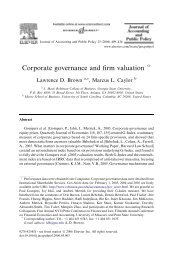Income Dynamics, Economic Rents and the Financialization of the ...
Income Dynamics, Economic Rents and the Financialization of the ...
Income Dynamics, Economic Rents and the Financialization of the ...
You also want an ePaper? Increase the reach of your titles
YUMPU automatically turns print PDFs into web optimized ePapers that Google loves.
Using National <strong>Income</strong> <strong>and</strong> Product Account data, Figures 1-2 extend <strong>the</strong>se time series to<br />
<strong>the</strong> present. 6 Figure 1 shows that <strong>the</strong> rise <strong>of</strong> <strong>the</strong> Finance Sector as a proportion <strong>of</strong> GDP reported<br />
by Krippner (2005) continued after 2001. 7 By 2007 this sector accounted for almost a quarter <strong>of</strong><br />
all income in <strong>the</strong> US economy. The relative decline <strong>of</strong> manufacturing continued as well.<br />
--Figure 1 about here--<br />
Following Krippner (fc) we report two measures <strong>of</strong> pr<strong>of</strong>its. The first we label pre-tax<br />
pr<strong>of</strong>its, this subtracts depreciation allowances from real net income. This exclusion is an ac-<br />
counting practice that recognizes that productive assets wear out. But it is also a policy lever that<br />
exempts some corporate pr<strong>of</strong>it from taxation, presumably in order to encourage capital invest-<br />
ment. Depreciation allowances change over time <strong>and</strong>, to some extent, vary by industry as Con-<br />
gress has attempted to encourage capital investment in specific industries (e.g. oil <strong>and</strong> gas explo-<br />
ration). Thus depreciation is an accounting practice that allows corporations to not count some <strong>of</strong><br />
6 The National <strong>Income</strong> <strong>and</strong> Product Accounts are produced by <strong>the</strong> US Bureau <strong>of</strong> <strong>Economic</strong><br />
Analysis <strong>and</strong> are <strong>the</strong> primary source <strong>of</strong> data used to estimate <strong>the</strong> Gross National Product <strong>of</strong> <strong>the</strong><br />
United States. These data are primarily derived from income tax returns aggregated to <strong>the</strong> indus-<br />
try level <strong>and</strong> so are more accurate than conventional survey data. See Appendix A for concor-<br />
dance we use to harmonize St<strong>and</strong>ard, North American, <strong>and</strong> Census Bureau Industrial Classifica-<br />
tions across time.<br />
7 Throughout this paper we display time series as ratios <strong>of</strong> national income. This mirrors our<br />
<strong>the</strong>oretical account <strong>of</strong> income rents developed in <strong>the</strong> next section, which treats income dynamics<br />
from a relational ra<strong>the</strong>r than absolute perspective. In addition, focusing on ratios simplifies com-<br />
parisons across time because <strong>the</strong>y control for dynamics associated with inflation, growth <strong>and</strong> to<br />
some extent <strong>the</strong> business cycle.<br />
8







